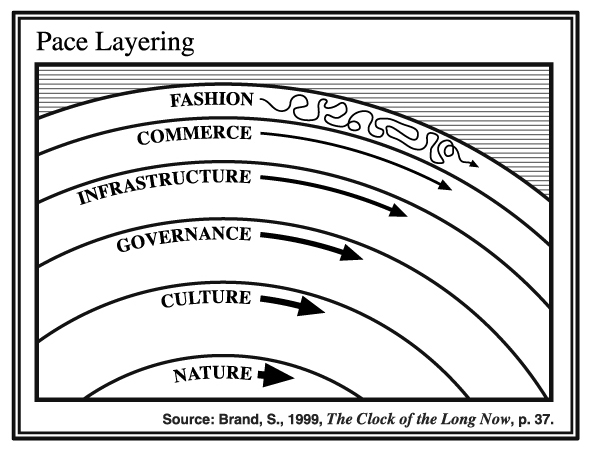One of my favorite diagrams is from Stewart Brand’s book “The Clock of the Long Now” Derived from a diagram in Brand’s prior book “How Building Learns”, alongside an idea of Freeman Dyson’s, Stewart Brand expands on the idea of the pace layers of civilization in The Clock of the Long Now. Here are some note from the chapter in which this diagram appears:
“The fast parts learn, propose, and absorb shocks; the slow parts remember, integrate, and constrain. The fast parts get all the attention. The slow parts have all the power.
We can examine the array layer by layer, working down from fast and attention-getting to slow and powerful. Note that as people get older, their interests tend to migrate to the slower parts of the continuum. Culture is invisible to adolescents but a matter of great concern to elders. Adolescents are obsessed by fashion, elders bored by it.
The job of fashion and art is to be froth: quick, irrelevant, engaging, self-preoccupied, and cruel. Try this! No, no, try this! Culture is cut free to experiment as creatively and irresponsibly as society can bear. From all this variety comes driving energy for commerce…and the occasional good idea or practice that sifts down to improve deeper levels, such as governance becoming responsive to opinion polls, or culture gradually accepting multiculturalism as structure instead of grist for entertainment.
If commerce is completely unfettered and unsupported by watchful governance and culture, it easily becomes crime…Likewise, commerce may instruct but must not control the levels below it, because commerce alone is too shortsighted.
Infrastructure, essential as it is, cannot be justified in strictly commercial terms. The payback period for such things as transportation and communication systems is too long for standard investment, so you get government-guaranteed instruments such as bonds or government-guaranteed monopolies. Governance and culture must be willing to take on the huge costs and prolonged disruptions of constructing sewer systems, roads, and communication systems, all the while bearing in mind the health of even slower “natural” infrastructure, such as water, climate and so on.
Education is intellectual infrastructure; so is science. Very high yield, but delayed payback.Culture’s vast slow-motion dance keeps century and millennium time. Slower than political and economic history, it moves at the pace of language and religion. Culture is the work of whole peoples.
As for nature, its vast power, inexorable and implacable, continues to surprise us….When we disturb nature at its own scale, as with our “extinction engine” and greenhouse gases of recent times — we risk triggering apocalyptic forces. Like it or not, we now have to comprehend and engage the still Longer Now of nature.
The division of powers among the layers of civilization allows us to relax about a few of our worries. We should not deplore rapidly changing technology and business while government controls, cultural mores, and so-called wisdom change slowly; that’s their job….The total effect of the pace layers is that they provide many-leveled corrective, stabilizing negative feedback throughout the system. It is precisely in the apparent contradictions of pace that civilization finds its surest health.”
